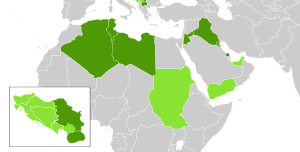
The dinar (/dɪˈnɑːr/) is the name of the principal currency unit in several countries near the Mediterranean Sea, with a more widespread historical use. The English word "dinar" is the transliteration of the Arabic دينار (dīnār), which was borrowed via the Syriac dīnarā, itself from the Latin dēnārius.[1][2]
The modern gold dinar is a projected bullion gold coin, and as of 2019[update] is not issued as an official currency by any state.
YouTube Encyclopedic
-
1/2Views:4312 054
-
🔥The Rate are Very Good This is Bigger RV Approved | Iraqi Dinar Latest News Today 20 October 2023 🔥
-
Announced 1 Iraqi Dinar equals $5.12 US Dollars | dinar News Today 13 October 2023
Transcription
History

The modern dinar's historical antecedents are the gold dinar and the silver dirham, the main coin of the medieval Islamic empires, first issued in AH 77 (696–697 AD) (Late Antiquity) by Caliph Abd al-Malik ibn Marwan. The word "dinar" derives from the Latin word "dēnārius," a silver coin of ancient Rome, which was first minted about c. 211 BC.
The Kushan Empire introduced a gold coin known as the dīnāra in India in the 1st century AD; the Gupta Empire and its successors up to the 6th century adopted the coin.[3][4]
The 8th century English king Offa of Mercia minted copies of Abbasid dinars struck in 774 by Caliph Al-Mansur with "Offa Rex" centred on the reverse.[5][6] The moneyer likely had no understanding of Arabic as the Arabic text contains many errors. Such coins may have been produced for trade with Islamic Spain. These coins are called a Mancus, which is also derived from the Arabic language.[citation needed]
Legal tender
Countries with current usage
Countries currently using a currency called "dinar" or similar:

| Countries | Currency | ISO 4217 code |
|---|---|---|
| Algerian dinar | DZD | |
| Bahraini dinar | BHD | |
| Iraqi dinar | IQD | |
| Jordanian dinar | JOD | |
| Kuwaiti dinar | KWD | |
| Libyan dinar | LYD | |
| Macedonian denar | MKN (1992–1993) MKD (1993−present) | |
| Serbian dinar | RSD CSD (2003–2006) | |
| Tunisian dinar | TND |
As a subunit
- 1⁄100 of the Iranian rial
Countries with former usage
Countries and regions which have previously used a currency called "dinar" in the 20th century:
| Countries | Currency | ISO 4217 code | Used | Replaced by |
|---|---|---|---|---|
| Bahraini dinar | BHD | 1966–1973 | United Arab Emirates Dirham | |
| Bosnia and Herzegovina dinar | BAD | 1992–1998 | Bosnia and Herzegovina convertible mark | |
| Croatian dinar | HRD | 1991–1994 | Croatian kuna | |
| Iranian rial was divided into at first 1250 and then 100 dinars | ||||
| South Yemeni dinar | YDD | 1965–1990 | Yemeni rial | |
| Sudanese dinar | SDD | 1992–2007 | Sudanese pound | |
| Yugoslav dinar | YUF (1945–1965) YUD (1965–1989) YUN (1990–1992) YUR (1992–1993) YUO (1993) YUG (1994) YUM (1994–2003) |
1918–2003 | Serbian dinar | |
See also
- Economy of the Organisation of Islamic Cooperation
- Kelantanese dinar
- Islamic State dinar
- List of circulating currencies
- Middle East economic integration
References
- ^ Oxford English Dictionary, Second edition, 1989, s.v. "dinar"; online version November 2010
- ^ Versteegh, C. H. M.; Versteegh, Kees (2001). The Arabic Language. Edinburgh University Press. p. 60. ISBN 978-0-7486-1436-3.
- ^ Friedberg, Arthur L.; Friedberg, Ira S. (2009). Gold Coins of the World: From Ancient Times to the Present. Coin & Currency Institute. p. 457. ISBN 978-0-87184-308-1.
- ^ Mookerji, Radhakumud (2007). The Gupta Empire. Motilal Banarsidass. pp. 30–31. ISBN 978-81-208-0440-1.
- ^ "Coin | British Museum".
- ^ Medieval European Coinage Archived 2023-08-12 at the Wayback Machine by Philip Grierson, p. 330.
External links
- Krause, Chester L.; Clifford Mishler (2003). 2004 Standard Catalog of World Coins: 1901–Present. Colin R. Bruce II (senior editor) (31st ed.). Krause Publications. ISBN 0873495934.
- Malaysia: Kelantan collects Zakat in Shariah money
